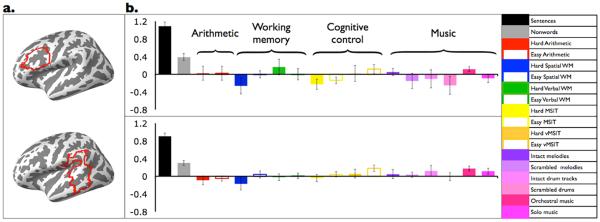Figure 2.
Functional response profiles of two high-level language processing brain regions. (A) Two functional “parcels” derived from a group-level representation of language activations (the LIFG and the LMidPostTemp parcels from Ref. 28) and used to constrain the selection of subject-specific regions of interest (ROIs). Individual ROIs were functionally defined: each parcel was intersected with the individual activation map for the language-localizer contrast (sentences > non-word lists28), and the top 10% of voxels were taken to be that participant’s ROI. (B) Responses to the language-localizer conditions and a broad range of nonlinguistic tasks. Responses to the sentences and non-word conditions were estimated using across-runs cross validation,59 so that the data to define the ROIs and to estimate their responses were independent. The data for the arithmetic, working memory (WM) and cognitive control (MSIT; Multi-Source Interference Task) tasks were reported in Ref. 60 and the data for the music conditions come from Ref 61; see also Refs. 60 and 62).

